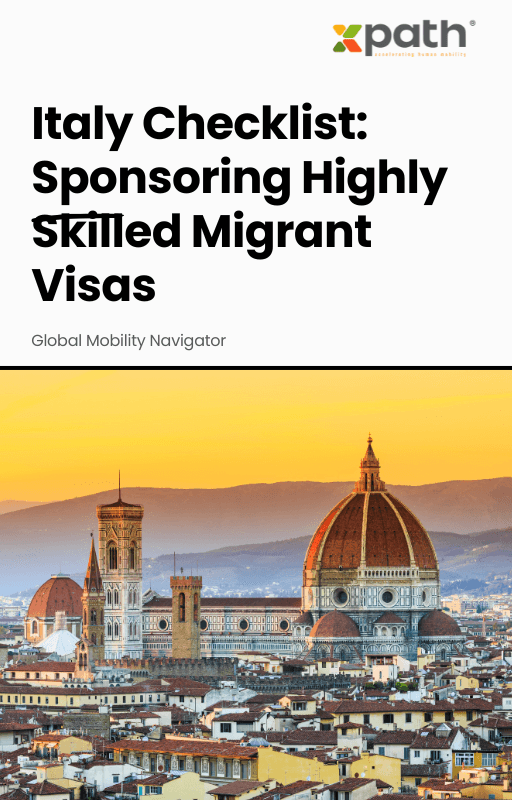Italy Checklist: Sponsoring Highly Skilled Migrant Visas
Grab a copy of a guide to international employee relocation
View E-bookAs businesses spread their wings across borders, global mobility programs have become the engines of growth and innovation. But with these exciting opportunities come a labyrinth of tax quagmires that can trip up even seasoned mobility professionals. If you’re orchestrating employee relocations, ignoring these pitfalls isn’t just risky – it could cost your organization time, money, and reputation. So how do you avoid walking into the quicksand of international taxation? Let’s break it all down together, keeping it straight, insightful, and actionable.
Sending employees abroad – whether for a short project or a multi-year assignment – is more than just booking tickets and finding homes. Every move can trigger a series of tax obligations, both for your company and the employee. Unlike domestic moves, cross-border assignments often mean double (or triple!) layers of reporting, withholding, and compliance requirements spanning multiple jurisdictions. And believe me, regulators are sharpening their pencils: According to Deloitte’s 2023 Global Mobility Trends Report, compliance complexity tops the list of employer challenges, with 68% of respondents citing international tax as a key concern.
If managing compliance for international moves feels like tiptoeing through a minefield, you’re not off the mark. Some of the most insidious tax traps include:
1. Dual Tax Residency: Nothing sours an overseas assignment faster than discovering you’re taxable in both your home and host country. “Tie-breaker” rules in international tax treaties may help, but missteps here are disturbingly common.
2. Permanent Establishment (PE) Risk: Did you know that sending the wrong employee abroad could inadvertently create a taxable presence for your company in the host country? The OECD notes that PE risk is on the rise as worker mobility increases post-pandemic.
3. Social Security Catch-22: Navigating social security contributions (both where and how much) is a notorious headache, especially if there’s no totalization agreement in play.
4. Shadow Payroll Mysteries: Are you maintaining a shadow payroll in the host country for tax reporting? Miss this step, and you could run afoul of local authorities – or worse, ignite tax audits.
5. Equity Compensation Chaos: Stock options, RSUs, and bonus programs often trigger unexpected tax charges once an employee crosses a border. In fact, a PwC survey found nearly 60% of assignees faced unanticipated tax liabilities due to equity-based rewards.
The world’s appetite for remote and flexible work is surging – but so are the taxman’s tools. In 2022, KPMG reported a 15% rise in cross-border audits focusing on employee mobility. Why the crackdown? Countries are eager to capture revenue from globally mobile workers, especially after pandemic-era fiscal deficits. Moreover, digital nomadism and hybrid assignments add complexity: According to EY, 32% of companies now face challenges determining the tax residence and reporting obligations of employees who work from multiple jurisdictions each year. The message is clear: Global mobility, if unmanaged, is a moving target for tax risk.
Let’s put theory into practice. Imagine TechCo, a rapidly scaling SaaS provider. They extended a “short-term” assignment for a product manager in Germany from six months to two years, without adjusting their payroll compliance. The result? Double taxation for the employee, hefty fines for the company, and a black mark on their compliance record. After consulting with global mobility experts and implementing a solution powered by xpath.global, TechCo automated their compliance monitoring, integrated shadow payroll management, and established alerts for key tax triggers. Within a season, TechCo slashed non-compliance risk by 80% and boosted employee satisfaction scores by double digits. Often, the difference between a tax trap and a tax triumph is being proactive and leveraging best-in-class technology.
So, how can you keep your mobility program on the straight and narrow? Start with a “tax-first” mindset. Organizations using advanced global mobility solutions – like xpath.global – experience fewer compliance headaches and happier expatriates. Here’s what you can do:
– Conduct pre-assignment tax briefings (no surprises, no regrets).
– Implement layered compliance monitoring tools that track payroll, immigration status, and tax residency triggers in real-time.
– Work with local experts, or leverage platforms with deep networks in every market.
– Don’t rely on one-size-fits-all policies; customize your tax strategy to each assignment, factoring in the duration, compensation structure, and employee seniority.
Remember, technology is your ally. Platforms such as xpath.global simplify processes by centralizing data, automating workflows, and providing actionable insights. That’s not just peace of mind — it’s a strategic advantage in a complex world.
The only constant in international tax? Change. Keeping ahead means investing in learning, technology, and relationships. The global workforce of tomorrow will be more mobile, more diverse, and more regulated than ever. By embracing smart solutions now and prioritizing transparency and compliance, you’re not just dodging tax traps — you’re laying the groundwork for sustainable, hassle-free mobility.
Global mobility tax traps are daunting, but not inevitable. With the right awareness, robust strategies, and smart tech partners like xpath.global, your organization can turn compliance risk into opportunity. Ready to transform your approach and protect your people, profits, and peace of mind?
1. What is the biggest risk in global mobility taxation?
Double taxation and non-compliance with host country laws are the top risks. Failing to recognize PE triggers can create corporate tax obligations abroad.
2. Do tax treaties always prevent double taxation?
Not always. They help, but local rules, timing, and income types matter. Expert guidance and tracking are crucial to ensure relief is available and applied correctly.
3. Can technology really help manage mobility tax risks?
Absolutely! Platforms like xpath.global aggregate compliance data, automate tasks, and give you real-time visibility into potential issues.
4. How frequently should I review my global mobility compliance framework?
At least annually, or when making changes to assignment structures, compensation models, or entering new countries.
Ready to transform your mobility program? Explore xpath.global’s solutions.

Italy Checklist: Sponsoring Highly Skilled Migrant Visas
Grab a copy of a guide to international employee relocation
View E-book